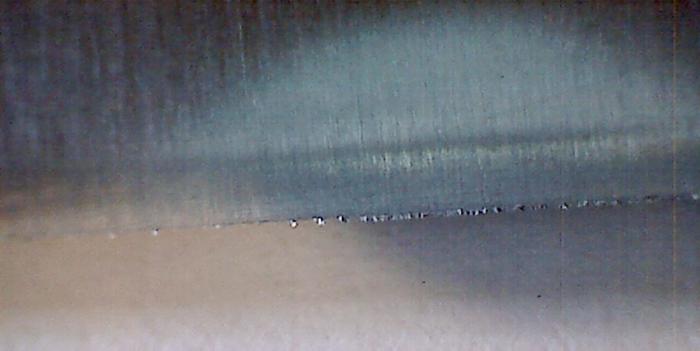Results 21 to 30 of 38
-
12-23-2016, 07:22 PM #21At this point in time...




- Join Date
- Jun 2007
- Location
- North Idaho Redoubt
- Posts
- 27,032
- Blog Entries
- 1
Thanked: 13246
Just came in from the shop and I snapped a pic for you as I am planning a series of "How NOT to Hone" so I am collecting pics
Why would I "Kill the Edge" before I start ???
If you look, and the edge like this one fresh off the buffers and see

Do a few laps or Circles "Kill the Edge" set the bevel, check the steel for micro-chipping again and decide what to do next...
Honing baby !!!! ain't it fun
-
12-23-2016, 07:26 PM #22Member

- Join Date
- Dec 2016
- Location
- Belgium/Antwerp
- Posts
- 51
Thanked: 0
Wow, thats one ****ed up edge :-O
Then I might be lucky with what I have bought to teach myself honing.
Was the edge rusted a lot?
-
12-23-2016, 07:32 PM #23illegitimum non carborundum



- Join Date
- Jan 2008
- Location
- Rochester, MN
- Posts
- 11,552
- Blog Entries
- 1
Thanked: 3795
But of course all of that would be eliminated as soon as the edge makes contact during the bevel set...

-
12-23-2016, 07:36 PM #24At this point in time...




- Join Date
- Jun 2007
- Location
- North Idaho Redoubt
- Posts
- 27,032
- Blog Entries
- 1
Thanked: 13246
No it was a brand new custom that was honed "Heavy Handed" without tape, so I am trying to get it back to looking better and shaving again...
This is what Rezdog/Shawn was talking about above in his first post about "Restoring" and finding this kind of stuff..
To be clear there are other techniques of removing this WITHOUT killing the edge, back honing and Pyramids come to mind
As long as you end up with a clean even solid bevel that is the goal..
Which is what he is implying above
You have to find what works best for you and the razor you are honing
Last edited by gssixgun; 12-23-2016 at 07:39 PM.
-
12-23-2016, 07:39 PM #25

Now that we have established that the methods are the same; I recommend that from this point on, we refer to this process as "Kill-Jointing".

Carry on ,,,,,,,,,,,,,
-
-
12-23-2016, 08:02 PM #26

My understandings come from the same background. I thought Bart was crazy when I first read that but now I understand. At that time, I had not heard all of the variables that folks encounter with 'new to them' razors.
Overhoning was never an issue for me as I didn't backhone at that time.
Great site we have here!
-
12-23-2016, 08:12 PM #27At this point in time...




- Join Date
- Jun 2007
- Location
- North Idaho Redoubt
- Posts
- 27,032
- Blog Entries
- 1
Thanked: 13246
-
12-23-2016, 08:31 PM #28illegitimum non carborundum



- Join Date
- Jan 2008
- Location
- Rochester, MN
- Posts
- 11,552
- Blog Entries
- 1
Thanked: 3795
Nope.
You've got to add Bread to the term in order to have the full tri-fecta.
-
12-23-2016, 09:27 PM #29Senior Member


- Join Date
- Apr 2008
- Location
- Saint Paul, Minnesota, United States
- Posts
- 2,944
Thanked: 433
So now "bread Kill Jointing knifing" is a thing, BKJK for short!
Personally I never use the kill on glass edge method unless I'm showing someone how to strop and don't want to wreak strops, I see no reason for it. I do use the jointing method when working on crumbly/chippy edges and for me, that works well for that
-
12-23-2016, 09:39 PM #30illegitimum non carborundum



- Join Date
- Jan 2008
- Location
- Rochester, MN
- Posts
- 11,552
- Blog Entries
- 1
Thanked: 3795
IF the science of sharp guy's photos can be believed, then glassing the edge might not be good for your strop. The photo showed that the edge folded over in an extreme "J" shape and this might lead to hook side of the "J" digging into the leather.
I've never tried it though. I just thought I'd toss it out for you to consider.


 63Likes
63Likes LinkBack URL
LinkBack URL About LinkBacks
About LinkBacks







 Reply With Quote
Reply With Quote


